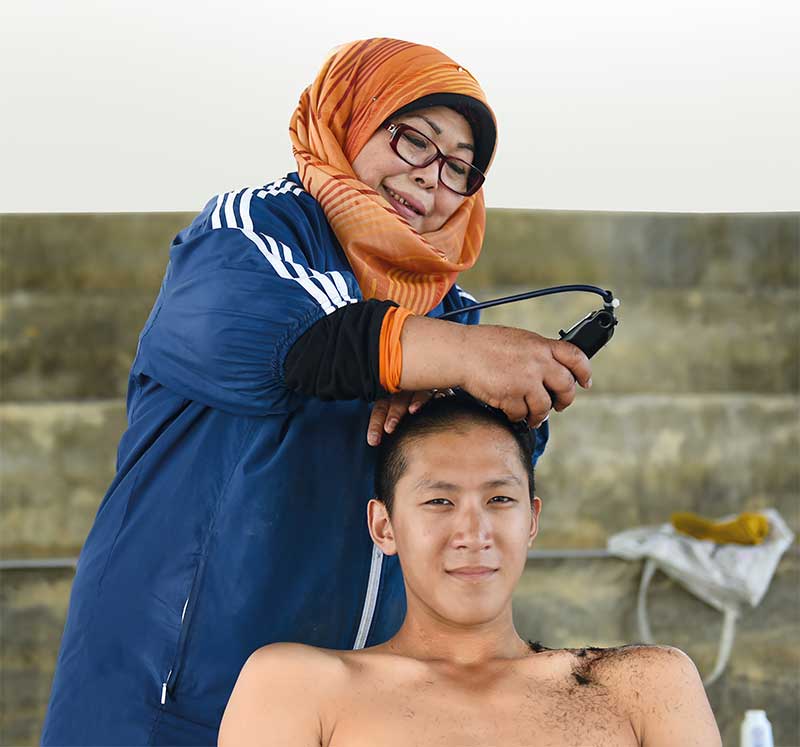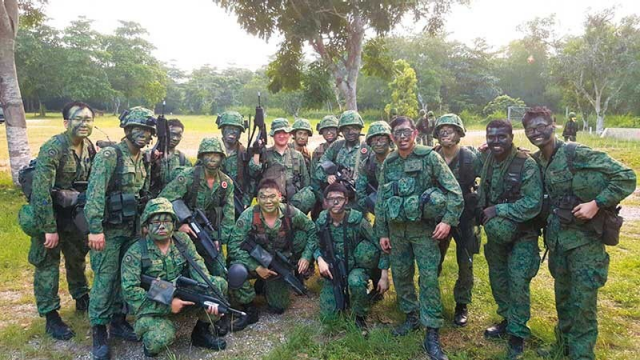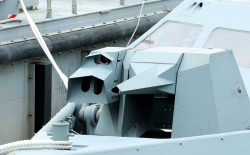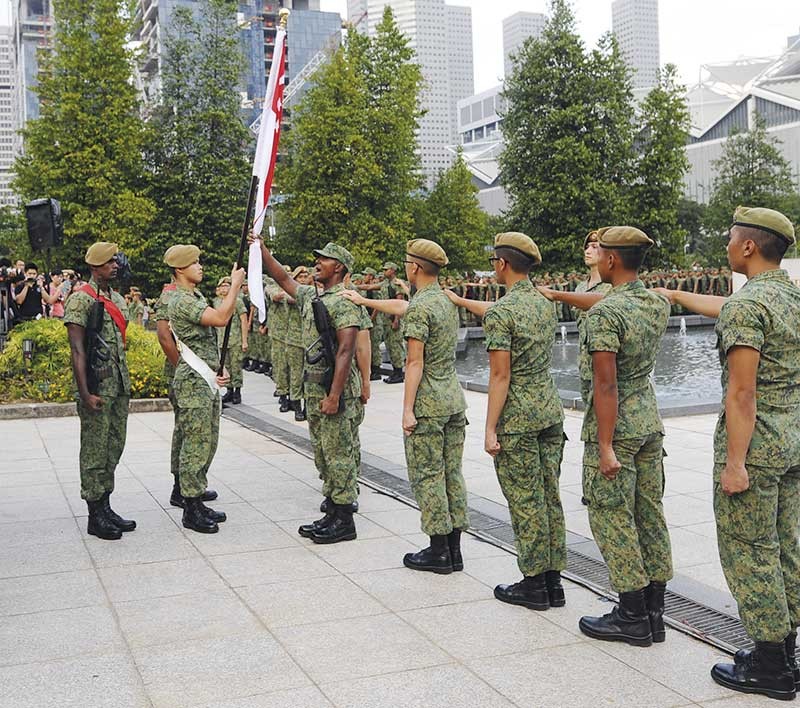In the 25th year of the SAF training at Shoalwater Bay Training Area (SWBTA), armoured vehicles and attack helicopters work together in a live-firing exercise that aims to be as realistic as possible.
The heavy vehicles are lined up at the edge of the forest. It is an impressive array of Leopard 2SG Main Battle Tanks, Bionix Infantry Fighting Vehicles (IFVs) and Mortar Tracked Carriers (MTCs), their barrels barely peeking out from the row of trees.
They lie in wait across the open field from their targets. There is a stillness in the air. It is the last day of Exercise Wallaby (XWB) 2015, and the outcome of weeks of training and preparation hinges on the next moment.
Suddenly, the blast of a Leopard tank rips through the silence. Following its lead, the Bionix IFVs and MTCs begin their attack on the enemy.
Amid the blinding explosions and deafening blares, four AH-64D Apache attack helicopters file in overhead one after the other.
They deftly navigate through the relentless dust clouds and blasts, raining fire on the enemy.
Their work done, the Apaches zip out, allowing the land vehicles to resume their attack.
With a final boom, the enemy is taken down. The Armoured Battle Group (ABG) has successfully completed its integrated live firing.
Witnessing the precision displayed by the various platforms, it is almost impossible to imagine that this 20-minute live firing was carried out by the ABG for the very first time on these exercise grounds without any rehearsals.
Expecting the unexpected
An unrehearsed live firing may seem unthinkable, but for the men and women of the Armour Formation, it's just another day at work.
The success of this live firing was achieved through the Armour Live Firing System (ALFS), which is unique to the Armour Formation. In the past, troops would travel to the live-firing sites and practise firing at targets with blank rounds, ahead of the live firing. Following the introduction of the ALFS in 2009, preparations are carried out at base camp, in classrooms and in the form of walk-throughs before the day of the live firing.
And if the idea of firing live rounds from heavy-duty vehicles sounds disconcerting, that's exactly the intention. The purpose of adopting the ALFS was to enhance training realism and prepare soldiers for a war scenario that is spontaneous and volatile.
"In operations, you don't have the opportunity to do a rehearsal on the actual ground," explained Lieutenant Colonel (LTC) Dean Yik, Commanding Officer of 40th Battalion, Singapore Armoured Regiment (40 SAR).
"And because we did not do any rehearsals on the actual ground, it gives the men a lot of confidence in their own abilities and those of their buddies and platoon-mates."
Corporal (CPL) Harish Kumar, a Section 2nd-In-Charge in 40 SAR, added: "The ALFS trains us to react to situations we have not seen before. As much as we can train and simulate, we don't know what it will be like on the day itself.
"It's a very good thing because in times of a real war, if we need to fight, they won't be giving us hints or maps. We have to adapt accordingly."
However, despite the lack of rehearsals, safety was not compromised. The soldiers had to undergo a rigorous five-phase qualification process before they could participate in the live firing.
Getting ready for fire
Preparation for the ABG live firing began about five days earlier. Troops gathered in small groups, practising with their weapons for the Technical Handling Test (THT). The THT is the first phase in the ALFS qualification process, and it familiarises soldiers with their rifle drills.
"It's a refresher before the live firing," said 3rd Sergeant (3SG) Syed Omar Assafi Alsagoff. As a Section Commander in 40 SAR, he oversaw his section's THT.
The 21-year-old Full-Time National Serviceman (NSF) saw to their practice personally and took great pride and responsibility in ensuring that they passed the test: "I trained with them until they knew what to do."
This was followed by phase two - the Table-Top Exercise (TTX) where troops and their commanders at Camp Growl gathered around a large map projected on the floor of a training room. Participants moved model pieces representing the vehicles and other components of the exercise around the map, as they went over the manoeuvres and tactics.
3SG Omar explained: "On the ground, we tend to be focused on ourselves, whereas at the TTX, we get to see the big picture and what others are doing while we are carrying out our roles. We confirm what's happening on the ground during the live firing and this makes it safer for the troopers."
In phase three, troops underwent platform drills under the watchful eyes of their commanders.
Gunners of tanks and Bionix IFVs practised drills like the clearing of their arms and changing of barrels, while simultaneously talking themselves through the detailed steps.
Phase four saw the participants undergoing wargaming - a physical walk-through of the manoeuvres while executing the exact actions they would expect to do during the live firing.
Led by their officers commanding, the troops moved around in their respective vehicle configurations, going over different scenarios.
They also carried the coloured flags that would be their means of communication at the live firing: green meant that a weapon was clear with no ammunition; blue and white meant that the weapon was loaded but not ready for firing; red meant that the weapon was ready to be fired; and yellow signalled a faulty weapon.
In the final phase, commanders travelled to the actual site ahead of the live firing to study the ground. Without a rehearsal, this was their only opportunity to take note of the terrain and target distance.
Integrated fighting
As this was the first XWB live firing that saw four Apaches exercising with armoured vehicles, coordination was of utmost importance to ensure the safety of all participants. To this end, the Air-Land Tactical Control Centre (ALTaCC) played a crucial role.
The ALTaCC makes use of information from various sources, including radars, to piece together air and land pictures. This forms a common operating picture that gives commanders enhanced situational awareness, enabling them to employ air power more effectively to complement land operations.
"The focus of our training is coordination (to ensure that) the entire operation is a seamless multi-Service exercise," said Captain (CPT) (NS) Massang Neil Ryan. As a Controller, he supports air assets in deconflicting flight paths and coordination.
"In times of war, we need to get this right (avoid fratricide), but we cannot compromise on operational readiness: there cannot be too much of a time lag between the army and air force firing," said the Air Warfare Officer (Command, Control and Communications) from 201 Squadron.
"That's where we come in as real-time coordinators with multiple platforms and agencies - to ensure that the airspace is clear for either party to continue the operations."
Integration and coordination are essential parts not only of XWB, but the entire SAF. Apache pilot CPT Eugene Chua from 120 SQN elaborated: "The SAF we operate in today is very much integrated. We don't operate as single entities, we fight as one.
"Unlike fighter planes that fly high, Apaches can fly low. Thus they are effective in fighting together with the Army. Our main role is to take out adversary tanks through precision strikes with the guys on the ground."
Day of reckoning
The weeks of intense preparation certainly showed at the live firing on 20 Nov 2015. Defence Minister Dr Ng Eng Hen, who witnessed the live firing, lauded the ABG for its successful exercise: "It gives me a lot of confidence as our boys are doing it professionally I can think of very few countries, if any, who train at this pace, at this level, in peacetime. The SAF is among the very few that do this."
LTC Yik was equally proud of his young soldiers, for many of whom this was their first overseas exercise. He said: "Since we landed about 12 days ago, it's been extremely intensive. We've had no rest, and yet they've all been there throughout and everybody has participated willingly. I think it's a sign of their positive energy. They have exceeded my expectations."







